Ganesha (also called Ganesh) is the elephant-headed Hindu god who is considered one of the most famous deities in Hinduism. He is the god of knowledge, intelligence and wisdom. He is also often referred to as the god of prosperity and patron saint for travelers.
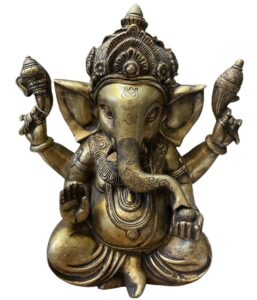
Seated Ganesha with food.
What is his story?
The story of Ganesha can be found in several historical Hindu sources, such as the Puranas, the Mahabharata and the Ramayana. Although the stories may differ slightly from each other, this is the most well-known version:
Ganesha is the son of Shiva (the god of destruction) and Parvati (the goddess of creation and fertility). During a conflict between father and son, Shiva accidentally – on impulse – cut off Ganesha’s head.
Parvati was devastated. Shiva promised to find a new head for his son so that he could live on. It had to be the head of the first creature they came across that looked north. That creature turned out to be an elephant, giving Ganesha an elephant head. This way, he was able to come back to life.
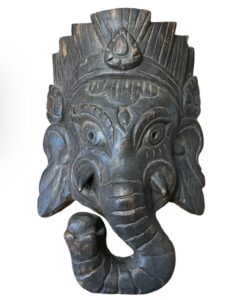
Small wooden Ganesha mask.
How to recognize Ganesha?
Ganesha is usually depicted with an elephant head, large belly and four arms. But there are different manifestations of him. For instance, he is also sometimes depicted with multiple arms and with different attributes (see below). He is also occasionally depicted on a throne or a lotus flower. As a Vahana (mount), he uses a rat or (pointed) mouse.
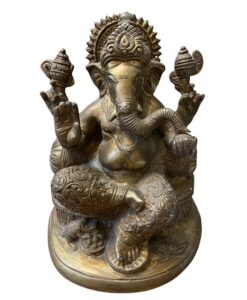
Seated Ganesha with crown. His rat is next to his foot.
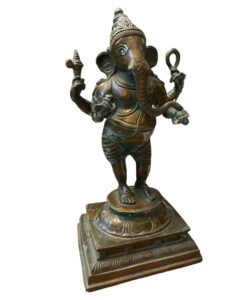
Standing Ganesha.
Of all the attributes, he most often carries the mace. This is his weapon to destroy obstacles with. In addition, he often carries a sweet delicacy, symbolizing success and spiritual knowledge. That delicacy might be modak, for instance. That is a sweet Indian dish made of dough filled with coconut, sugar, cardamom, nuts and dried fruits.
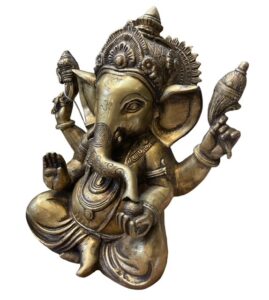
Seated Ganesha with food.
Symbolism of his body parts
Each body part has a certain symbolic meaning. For instance, his elephant head represents wisdom and intelligence, an association common in several cultures. His trunk symbolizes (spiritual) strength and flexibility. His eyes are small, indicating concentration. By focusing his gaze, he does not allow himself to be distracted from his task of removing obstacles. His large ears symbolize listening and absorbing knowledge. His large belly is interpreted in various ways, including as a symbol of the cosmos. The belly can also signify abundance and pleasure (he eats a lot and enjoys life).
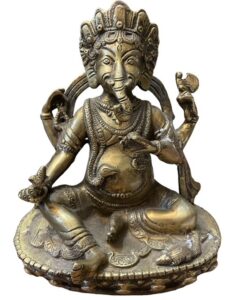
Seated Ganesha.
Worshipping
People worship Ganesha at different times and for different reasons. For instance, he is worshipped by travelers, to get protection. And by students because he is associated with intelligence. But people also worship him for success in new (spiritual or material) ventures. Therefore, he is often found near entrances to houses and temples, or on the road.
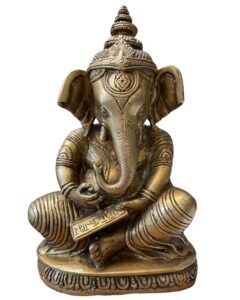
Writing Ganesha.
For some, it is tradition to stroke his trunk to receive blessings for good luck, success and overcoming obstacles. Therefore, the trunk of a stone statue may be smoother than the rest of the statue because of friction.
Also, the delicacy with which he is sometimes depicted – modak – is used for offerings to the god. By doing this, people hope to receive his sympathy and blessings.
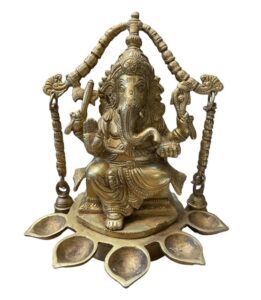
Ganesha Deepak with bells and sacrificial containers.
Rootz Gallery Collection
At Rootz Gallery, we sell a lot of different kinds of Ganesha statues and masks. All the photos used in this article are photos of items from our collection. Feel free to contact us if you are interested (send an email to info@rootz.gallery).
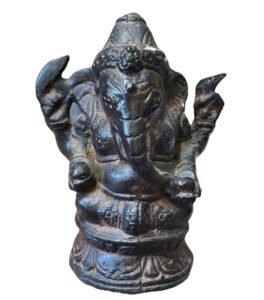
Dark bronze Ganesha statuette.
